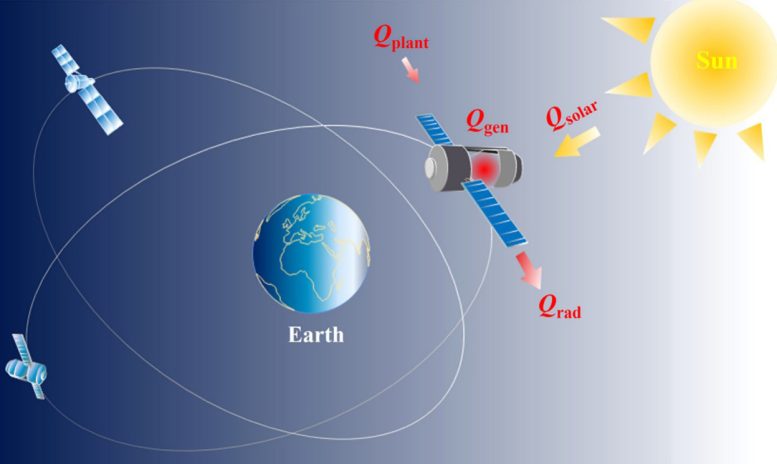
New research examines advanced thermal management technologies essential for the reliability and performance of spacecraft electronics, discussing materials, structures, and systems that mitigate heat challenges in space missions. Schematic of the thermal environment for electronics in spacecraft. Credit: Yi-Gao Lv, et al.
A new review details advancements in thermal management technologies for spacecraft, essential for improving the reliability and performance of space missions.
A new review examines advancements in thermal management technologies (TMTs) for spacecraft electronics, tackling the problems of heat acquisition, transport, and rejection in the extreme conditions of space. This review is intended to inform the development of future thermal management systems for spacecraft, enhancing both the reliability and effectiveness of space missions.
Spacecraft electronics operate under extreme conditions, facing issues like microgravity, thermal cycling, and space radiation. These factors necessitate robust thermal management solutions to maintain the functionality and longevity of onboard equipment. Traditional thermal control methods often fall short in addressing these challenges. Based on these challenges, there is a need to conduct in-depth research on advanced thermal management technologies to ensure the stability and efficiency of space missions.
In-depth Review of Advanced TMTs
A comprehensive review by researchers from Xi’an Jiaotong University and the Xi’an Institute of Space Radio Technology, published recently in the journal Energy Storage and Saving, delves into advanced thermal management technologies for spacecraft electronics. The study categorizes these technologies based on heat transfer processes, including heat acquisition, transport, and rejection.
The review evaluates thermal management technologies (TMTs) for spacecraft electronics, focusing on heat acquisition, transport, and rejection. It explores high thermal conductance materials like carbon-based composites and annealed pyrolytic graphite (APG) and discusses novel packaging structures using micro-/nano-electromechanical system (MEMS/NEMS) technologies. Heat transport solutions, including various heat pipes and mechanically pumped fluid loops (MPFLs), are examined, with heat pipes categorized into unseparated and separated types. Advanced microfluidic cooling techniques for efficient heat removal are also highlighted. For heat rejection, the review focuses on deployable radiators, variable emissivity radiators, and phase change materials (PCMs), addressing the fluctuating thermal environment in space to ensure effective heat dissipation.
Dr. Wen-Xiao Chu, the corresponding author of the study, states, “Our review highlights the critical advancements in thermal management technologies that are essential for the success of future space missions. By addressing the unique thermal challenges in the spacecraft environment, these technologies ensure the reliability and performance of onboard electronics, paving the way for more ambitious space exploration and satellite missions.”
Advancements in thermal management technologies have significant implications for the space industry. By ensuring efficient heat control, these technologies enhance the reliability and lifespan of spacecraft electronics, crucial for long missions. Lightweight and high-performance TMTs improve overall efficiency and cost-effectiveness. As demand for high-power and miniaturized space systems grows, implementing these advanced thermal solutions is vital for the future of space exploration and satellite technology.
Reference: “Review on Thermal Management Technologies for Electronics in Spacecraft Environment” by Yi-Gao Lv, Y Yi-Gao Lv, Yao-Ting Wang, Tong Meng, Qiu-Wang Wang and Wen-Xiao Chu, 28 March 2024, Energy Storage and Saving.
DOI: 10.1016/j.enss.2024.03.001
The study was funded by the National Science Foundation of China and the Science Fund Program for Distinguished Young Scholars (Overseas).









Be the first to comment on "Space Race Heats Up: Tackling Thermal Challenges Beyond Earth"